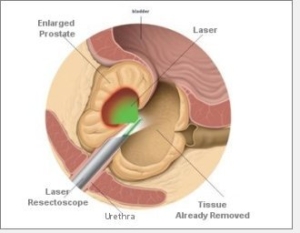Greenlight Laser Trans Urethral Vaporization of Prostate
This is an endoscopic technique of enucleation of the prostate using Greenlight laser therapy. Similar to a TURP – “Re-bore” only with minimal bleeding and shorted hospital stays. Some would argue this is ” The new Gold Standard”
Why is it done?
Endoscopic vaporization of a benign enlarged prostate, using laser.
Indications:
- Patients on anticoagulation / anti-platelet therapy
- Warfarin needs to be placed on Clexane 7 days prior.
- Clopidogrel should be down scaled down to Aspirin.
- This allows patients on anti-coagulation therapy to continue their medication with minimal risk of hemorrhage. It also allows a shorter stay in hospital.
- Prostates up to 120cc.
- Where conservative management has failed.
- Patient choice.
- This procedure is performed when the prostate gland is enlarged to such an extent that medication cannot relieve the urinary symptoms.
- Symptoms include: LUTS
- a weak stream,
- nightly urination,
- frequent urination,
- inability to urinate,
- kidney failure due to the weak urination (obstruction),
- bladder stones,
- recurrent bladder infections.
- Medication such as Flomaxtra, Urorec or Minipress etc. should always be given as a first resort.
- Step-up therapy could have been used for prostates larger than 35-50cc where indicated, with either Duodart, Avodart or Proscar.
- Prostate cancer first needs to be ruled out by doing a PSA, and when indicated, with a 3T MRI scan of the prostate with an abnormal PSA with a possible prostate biopsy of any suspicious lesions.
How is it done?
-
- Patients will receive a general anesthesia, unless contra-indicated.
- A cystoscopy is performed by placing a camera in the urethra with the help of lignocaine gel.
- Saline is used to irrigate the bladder, therefore NO DILUTIONAL HYPONATRAEMIA
- The inside of the bladder is viewed for pathology. If any suspicious lesions are seen, a biopsy will be taken.
- A vaporization of the prostate is then started and should take 60-120 minutes depending on the size of the prostate.
- Prophylactic antibiotics will be given to prevent any infections.
- Post– operative antibiotics will be continued for 10 days.
- No specimen will be obtained due to vaporization, unless PSA was suspicious and an MRI with view to prostate biopsy has excluded a prostate cancer.
What can go wrong?
- Any anesthesia has its risks, and the anesthetist will explain this to you.
- No blood loss is expected.
- In rare circumstances you may develop fluid overload requiring a High Care Facility admission, especially with the upper edge of prostate sizes.
- You will wake up with a catheter in your urethra and bladder. This will remain in the bladder overnight.
- Lower abdominal discomfort for a few days.
- NB! Each person is unique and for this reason symptoms vary!
What next?
- You will spend 1 night in hospital.
- You will a trial without catheter the next day.
- You will be discharged as soon as you can completely empty your bladder.
- You may initially suffer from urge incontinence and dysuria (discomfort) and will improve within the next 6 weeks.
- You will pass a grey, wet scab at the 2–3-week mark.
- Some bleeding may be associated with this, especially if you are on anticoagulation therapy.
- Allow for 6 weeks for stabilization of symptoms.
- There may be some blood in your urine. You can remedy this by drinking plenty of fluids until it clears.
- A follow-up appointment will be scheduled for 6 weeks. Remember there is no pathology due to vaporization.
- DON’T SUFFER IN SILENCE, OR YOU WILL SUFFER ALONE!
Side–effects
- Retrograde ejaculation in more than 90% of patients. Therefore, if you have not completed your family, this procedure is not for you unless absolutely necessary.
- Infertility as a result of the retrograde ejaculation. Not a given, therefore continue your contraceptives
- Stress incontinence especially in the elderly and the diabetic patients.
- Patients with Multiple Sclerosis, Strokes and Parkinsons have a higher risk of incontinence and risks should be discussed and accepted prior to surgery.
- Urethral stricturing in <2% of patients, requiring intermittent self-dilatation.
- Regrowth of prostate lobes can occur within 3-5 years requiring a second procedure.
- NB! Each person is unique and for this reason symptoms vary!
Remember
- You still have a peripheral zone of your prostate and regular PSA reviews are required up to the age of 75. (This could be seen as controversial).
Download Information Sheet


Leave a Reply
Want to join the discussion?Feel free to contribute!